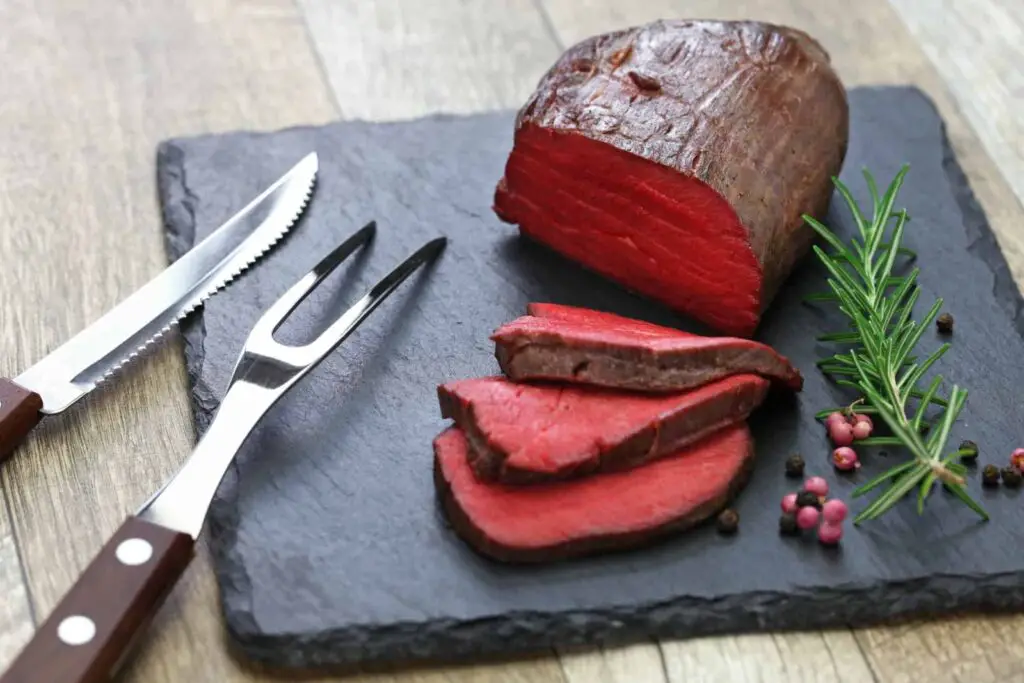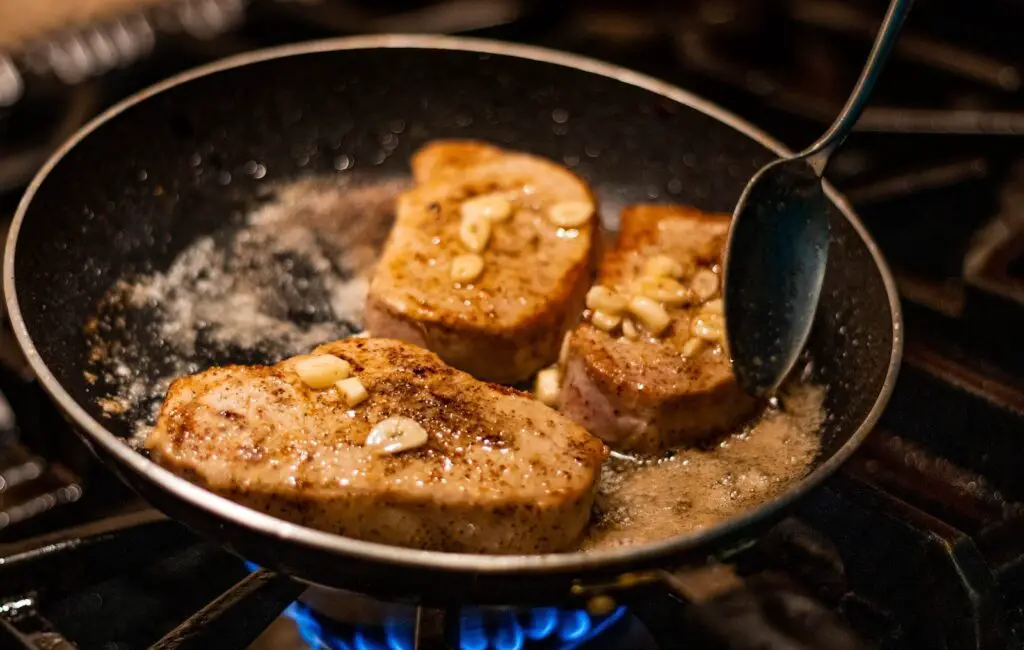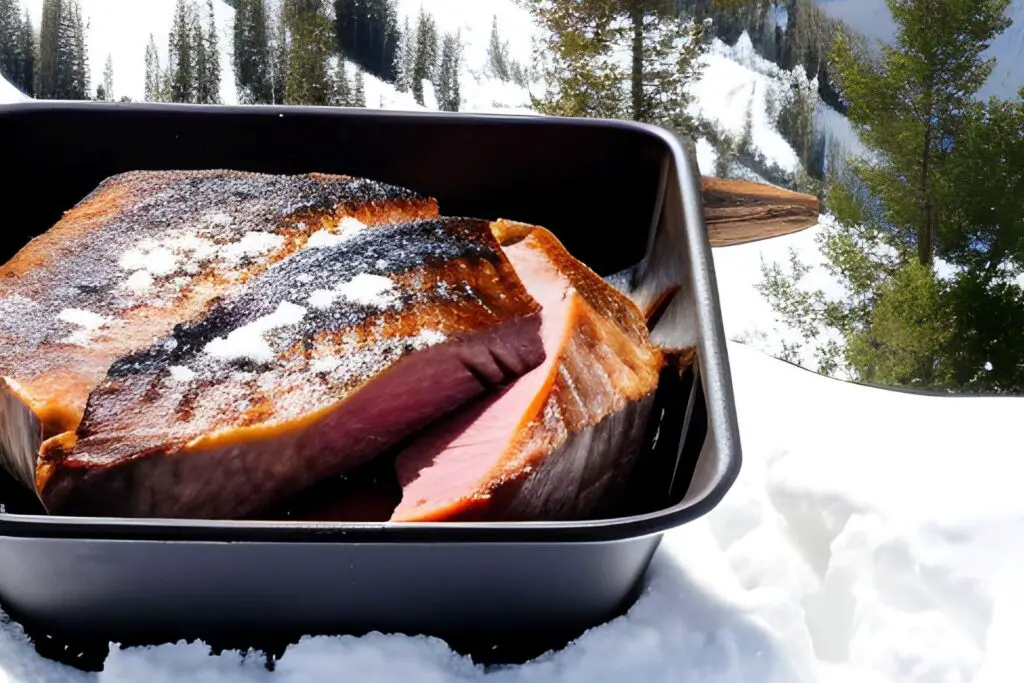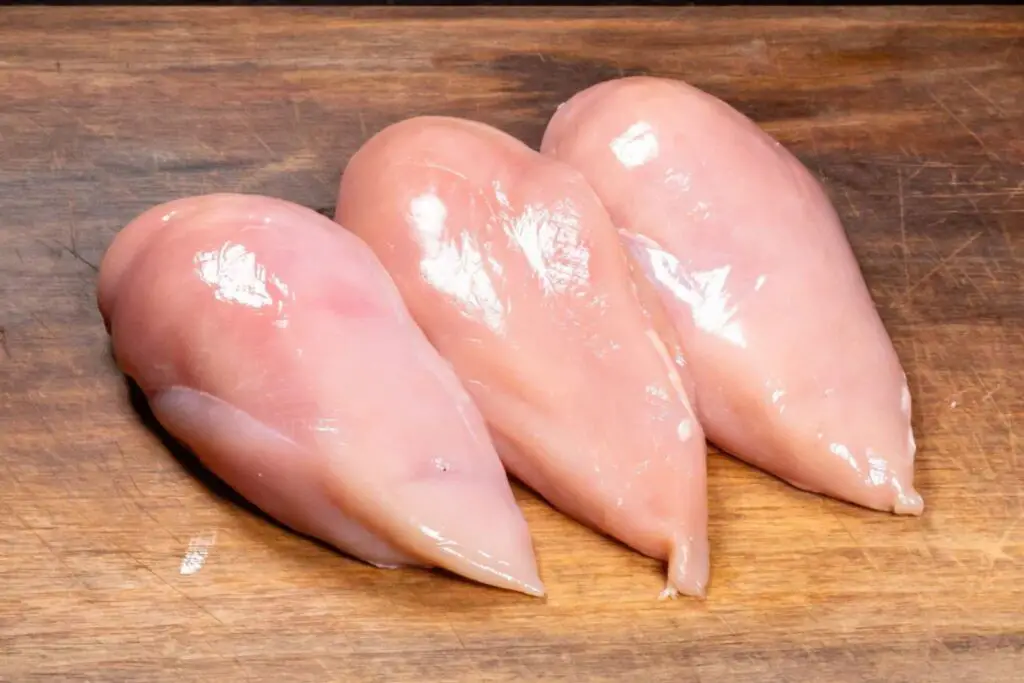
Smoked ham is a delectable and savory meat that is a favorite for many meat lovers. Whether you’ve prepared or purchased a large smoked ham and want to preserve its freshness, freezing is an excellent option. Freezing smoked ham ensures that you can enjoy its rich flavor and juicy texture even when it’s not readily available. To maintain the quality of the smoked ham during freezing, it’s crucial to follow some simple steps. This article presents a step-by-step guide on how to freeze smoked ham properly, ensuring its taste and texture are well-preserved for future use.
Here’s a comprehensive guide on freezing smoked ham:
Step 1: Select your smoked ham
Selecting a high-quality smoked ham is crucial for ensuring the best results when freezing it. Here’s why it’s important to pay attention to the type and quality of the smoked ham:
- Flavor and Texture: The quality of the smoked ham directly affects its flavor and texture. High-quality smoked ham will have a rich, smoky flavor and a tender, juicy texture. On the other hand, low-quality or poorly smoked ham may taste bland or have a tough, dry texture.
- Preservation: Freezing smoked ham is a way to preserve its freshness for an extended period. However, freezing cannot improve the quality of the ham if it’s already of low quality. Selecting a good-quality smoked ham ensures that its delicious flavors and desirable texture are preserved during the freezing process.
- Safety: Choosing fresh smoked ham that has not been previously frozen reduces the risk of bacterial contamination. Meat that has been frozen and thawed multiple times may be more susceptible to harmful bacteria, compromising food safety.
- Cooking Outcome: Whether you plan to use the smoked ham in sandwiches, soups, casseroles, or other dishes, the quality of the ham will influence the final outcome of your recipes. High-quality smoked ham enhances the overall taste and enjoyment of the prepared meals.
- Nutritional Value: Higher-quality smoked ham generally contains better nutritional content. It provides essential nutrients like protein, vitamins, and minerals, making it a healthier choice for your meals.
- Customization: By selecting the type of smoked ham that suits your preferences, you can tailor your recipes to your taste. Some people prefer whole smoked hams for special occasions or large gatherings, while others may opt for pre-sliced portions for convenience and portion control.
- Ethical Considerations: Opting for high-quality smoked ham from reputable sources may also align with ethical considerations related to animal welfare and sustainable farming practices.
To ensure you get the most out of your frozen smoked ham, take the time to choose a product that has been well-prepared and meets your specific requirements. Look for smoked ham from trusted suppliers or brands known for their quality. If possible, seek recommendations from friends, family, or local butchers who can provide insight into the best options available. With a well-selected smoked ham, you’ll be on your way to freezing a delicious and satisfying culinary delight that can be enjoyed whenever you desire.
Step 2: Prepare the packaging
Properly preparing the packaging is essential when freezing smoked ham to ensure its quality and prevent freezer-related issues. Here’s why selecting the right freezer-safe packaging and handling it appropriately is crucial:
- Prevent Freezer Burn: Freezer burn occurs when the surface of the smoked ham is exposed to air, causing moisture loss and oxidation. By using freezer-safe packaging, you create a barrier that helps to minimize air exposure, reducing the risk of freezer burn. This ensures that the smoked ham retains its moisture and flavor during freezing.
- Preserve Taste and Texture: The packaging you choose plays a significant role in preserving the taste and texture of the smoked ham. Airtight containers, vacuum-sealed bags, and heavy-duty freezer bags help maintain the ham’s natural juiciness and prevent it from absorbing unwanted odors from the freezer.
- Avoid Cross-Contamination: Using clean and dedicated freezer-safe packaging for the smoked ham helps avoid cross-contamination with other foods in the freezer. This is particularly important if you store various foods in the same freezer, as it prevents any potential transfer of flavors or bacteria between items.
- Space Management: Make sure the packaging is large enough to comfortably hold the smoked ham without overcrowding. Overcrowding can lead to uneven freezing and may affect the texture and quality of the ham. Adequate space ensures that the cold air circulates freely around the ham, promoting even freezing.
- Convenient Portioning: Choosing appropriate packaging also allows you to portion the smoked ham according to your needs. If you have a large smoked ham but only need to use a portion at a time, individual packaging makes it easier to thaw and use only what you require.
- Easy Organization: Properly labeled and sealed packaging makes it easier to identify the smoked ham in the freezer. Labeling the packages with the freezing date allows you to keep track of the storage time, ensuring you use the oldest ham first to maintain freshness.
- Food Safety: Freezer-safe packaging materials are designed to withstand low temperatures and prevent contamination. Using materials not specifically meant for freezing may result in packaging failure, leading to potential food safety risks.
When preparing the packaging, ensure it is clean and free of any contaminants. Wash airtight containers or freezer bags with warm, soapy water, and rinse them thoroughly before use. If using vacuum-sealed bags, make sure they are compatible with your vacuum sealer to ensure a tight seal.
Step 3: Portion the smoked ham (optional)
Portioning the smoked ham before freezing is an optional step, but it offers several advantages that can make meal planning and preparation more convenient. Here’s why dividing a large smoked ham into smaller portions can be beneficial:
- Flexible Usage: By dividing the smoked ham into smaller portions, you have the flexibility to use only what you need for a specific meal or recipe. This prevents unnecessary thawing and refreezing of the entire ham, which could compromise its quality.
- Reduced Waste: Portioning the smoked ham allows you to minimize food waste. If you freeze the entire ham but don’t plan to use it all at once, there’s a risk that some parts may remain unused and eventually go to waste. Smaller portions ensure that you can use the smoked ham more efficiently.
- Easier Thawing: Thawing a smaller portion of smoked ham takes less time than thawing a large ham. This can be particularly beneficial when you need a quick and convenient meal solution.
- Convenient Meal Preparation: Having pre-portioned smoked ham on hand makes meal preparation more convenient. You can easily grab the right amount of ham for sandwiches, omelets, casseroles, or any other dish, without the need to thaw more than necessary.
- Customizable Serving Sizes: Portioning the smoked ham allows you to customize serving sizes according to individual preferences or the number of people you’re serving. This is especially useful when hosting gatherings or preparing meals for different family members.
- Even Freezing: Smaller portions of smoked ham freeze more quickly and evenly than a large piece. This helps maintain the ham’s quality and ensures that each portion freezes at a consistent rate.
When dividing the smoked ham into portions, consider the amount you typically use in a single serving or recipe. Use a sharp knife to cut the ham into slices or smaller chunks, depending on your preferences and intended uses.
Before portioning, make sure the smoked ham is cooled to room temperature or slightly chilled in the refrigerator. This makes it easier to handle and reduces the risk of bacteria growth during the cutting process.
Step 4: Wrap the smoked ham
Wrapping the smoked ham tightly with either plastic wrap or aluminum foil is a crucial step to ensure its quality and preserve its flavor and moisture during freezing. Here’s why this additional layer of wrapping is essential:
- Protection Against Freezer Burn: Freezer burn occurs when food is exposed to air and undergoes dehydration. Wrapping the smoked ham with plastic wrap or aluminum foil creates a barrier that helps prevent air from coming into direct contact with the surface of the ham. This reduces the risk of freezer burn, which can negatively impact the taste and texture of the ham.
- Retention of Moisture: Smoked ham contains natural juices that contribute to its succulence and flavor. Wrapping the ham tightly helps trap these juices and prevents them from evaporating during freezing. This ensures that the ham remains moist and tender when thawed and cooked later on.
- Preservation of Flavor: By preventing the ham’s exposure to air, the additional layer of wrapping helps retain its distinct smoky flavor. Unprotected smoked ham can absorb unwanted odors from the freezer, compromising its taste.
- Minimization of Odor Transfer: Wrapping the smoked ham securely helps prevent the transfer of odors between different foods stored in the freezer. This is particularly important if you have various items in the freezer, as it ensures the ham maintains its original taste and aroma.
- Facilitation of Even Freezing: Properly wrapped smoked ham allows for even freezing, ensuring that the entire piece freezes uniformly. Even freezing helps maintain the ham’s quality and prevents the formation of ice crystals, which can affect its texture.
- Easy Handling: Wrapping the smoked ham individually makes it easier to handle and stack in the freezer. It prevents the ham from sticking to other items or surfaces, allowing you to organize the freezer efficiently.
When wrapping the smoked ham, ensure that it is completely covered without any exposed areas. If using plastic wrap, wrap it tightly around the ham, pressing the wrap against the surface to eliminate any air pockets. If using aluminum foil, fold the edges securely to create a tight seal.
If your smoked ham comes pre-packaged, and the packaging is intact and freezer-safe, you may not need an additional layer of wrapping. However, if the original packaging is damaged or not freezer-safe, it’s still advisable to re-wrap the ham for optimal preservation.
Step 5: Place in the packaging
Placing the wrapped smoked ham into the chosen packaging is a crucial step in the freezing process. The type of packaging you use can affect the ham’s quality and how well it maintains its flavor and texture during freezing. Here’s why this step is essential and why specific considerations are necessary based on the type of packaging used:
- Avoiding Freezer Burn: Proper packaging ensures that the smoked ham is well-protected from air exposure. Freezer bags and airtight containers create a sealed environment, reducing the risk of freezer burn. Freezer burn can cause the surface of the ham to dry out and become discolored, negatively affecting its taste and texture.
- Squeezing out Air from Freezer Bags: When using freezer bags, it’s important to remove as much air as possible before sealing. Air contains moisture, and any trapped air inside the bag can lead to freezer burn. Squeezing out the air creates a tight seal and helps maintain the ham’s freshness.
- Leaving Space in Containers: For airtight containers, leaving a little space at the top allows for slight expansion during freezing. As liquids freeze, they can expand, and leaving some room prevents the container from cracking or bursting. However, avoid leaving too much empty space, as excess air can lead to freezer burn.
- Properly Sealed Packaging: Ensure that the packaging is tightly sealed to prevent air from entering and moisture from escaping. A properly sealed package helps maintain the smoked ham’s moisture and flavor throughout its time in the freezer.
- Efficient Storage: Placing the wrapped smoked ham in freezer bags or containers makes it easier to stack and organize in the freezer. It also minimizes the ham’s exposure to air when opening the freezer, further reducing the risk of temperature fluctuations.
- Maintaining Quality: Proper packaging and placement in the chosen containers help maintain the smoked ham’s quality during freezing. It ensures that the ham remains juicy, flavorful, and safe to eat when thawed and cooked later on.
When using freezer bags, make sure to use heavy-duty freezer-safe bags that are designed to withstand low temperatures. Press out the air by gently squeezing the bag starting from the top, then seal it securely.
For airtight containers, choose containers made explicitly for freezing and ensure they have a tight-fitting lid. Avoid using containers that may crack or break under freezing temperatures.
Is vacuum-sealing necessary for freezing smoked ham?
While vacuum-sealing can provide an extra layer of protection against freezer burn, it is not strictly necessary. Using airtight freezer bags or containers can also effectively preserve the smoked ham’s quality and prevent air exposure during freezing.
Step 6: Label and date the packages
Labeling and dating the packages of frozen smoked ham is a crucial organizational step that helps you keep track of storage time and ensures you use the oldest packages first. Here’s why this step is essential:
- Rotation and Freshness: By labeling and dating each package, you can easily identify the time when the smoked ham was frozen. This allows you to practice a “first in, first out” approach when using the ham. Using the oldest packages first ensures that you consume the smoked ham while it is still at its freshest and best quality.
- Preventing Food Waste: Smoked ham, like any frozen food, has a limited shelf life in the freezer. Labeling and dating the packages enable you to monitor the storage duration and avoid accidentally keeping the smoked ham past its recommended storage time. This reduces the risk of freezer burn or degradation in flavor and texture, thus minimizing food waste.
- Food Safety: Knowing the freezing date allows you to gauge the safety of the smoked ham. While frozen foods can be safe to eat for an extended period, maintaining an accurate record helps you avoid consuming smoked ham that has been frozen for an excessively long time.
- Meal Planning: Having a clear indication of the freezing date helps with meal planning and preparation. It allows you to incorporate frozen smoked ham into your menu based on its remaining shelf life, ensuring you use it in various recipes before its quality begins to decline.
- Inventory Management: If you have multiple packages of smoked ham with different freezing dates, labeling them becomes particularly beneficial. You can easily keep track of your inventory and choose which packages to use based on their freshness.
- Convenience: Labeling the packages with the freezing date ensures that you don’t have to rely on memory or guesswork about when the ham was frozen. It provides a quick reference, making the process of selecting the appropriate package for use more straightforward and convenient.
To label the packages, use a marker or adhesive label and write the freezing date clearly on each package. Include the day, month, and year to ensure accurate tracking. If you have divided the smoked ham into smaller portions, label each portion accordingly.
Step 7: Store in the freezer
Storing the properly packaged and labeled smoked ham in the freezer is the final step in the freezing process. The way you store the ham in the freezer directly impacts its quality and longevity. Here’s why this step is crucial:
- Preservation of Quality: The freezer’s low temperature slows down the natural processes of deterioration, helping preserve the quality of the smoked ham. By storing it at 0°F (-18°C) or lower, you maintain the ham’s texture, flavor, and nutritional value over an extended period.
- Prevention of Spoilage: Freezing at the recommended temperature prevents the growth of harmful bacteria and microorganisms that can lead to food spoilage. This ensures that the smoked ham remains safe to eat throughout its storage time in the freezer.
- Minimization of Freezer Burn: Storing the smoked ham at the correct temperature helps minimize the risk of freezer burn. At 0°F (-18°C) or lower, the freezing process is more efficient, reducing the formation of ice crystals on the ham’s surface and preventing dehydration.
- Even and Consistent Freezing: The coldest part of the freezer ensures that the smoked ham freezes evenly and consistently. Even freezing helps maintain the ham’s texture and prevents the development of icy or mushy spots.
- Optimal Freezer Organization: Placing the smoked ham in the coldest part of the freezer allows for efficient use of space. It helps keep the ham well-separated from other foods, reducing the risk of cross-contamination and ensuring easy access to the ham when needed.
- Longer Shelf Life: Storing the smoked ham at the recommended temperature extends its shelf life. While frozen ham can be safe to eat for several months, maintaining the freezer at the right temperature ensures that the ham maintains its best quality for the longest possible time.
When placing the smoked ham in the freezer, avoid overcrowding the freezer shelves or drawers. Leave enough space around the packages to allow cold air to circulate freely. Overcrowding can lead to uneven freezing and may compromise the quality of the smoked ham.
Additionally, if your freezer has a quick-freeze or rapid-freeze feature, you can use it when storing the smoked ham. This function helps lower the temperature quickly, reducing the risk of temperature fluctuations and ensuring the ham freezes faster, which is beneficial for quality preservation.
How long can smoked ham last in the freezer?
Smoked ham can last in the freezer for about 1 to 2 months without significant quality loss. For optimal flavor and texture, it is recommended to consume it within the first month of freezing. Properly stored smoked ham can remain safe to eat for an extended period, but the quality may decline after the recommended storage duration.
Step 8: Thaw the frozen smoked ham
Thawing frozen smoked ham safely is crucial to maintain its quality and ensure it remains safe to eat. Here’s why the method of thawing is important and why specific approaches are recommended:
- Preserving Texture and Flavor: Slow thawing in the refrigerator allows the smoked ham to thaw gradually and evenly, preserving its texture and flavor. This method minimizes the risk of moisture loss and helps the ham retain its natural juiciness and succulence.
- Reducing the Risk of Bacterial Growth: Slow thawing in the refrigerator is a safe method that prevents the smoked ham from entering the “danger zone” (40°F to 140°F or 4°C to 60°C). The danger zone is the temperature range at which bacteria multiply rapidly. By keeping the ham at a controlled and consistent temperature during refrigerated thawing, you reduce the risk of bacterial growth.
- Even Thawing: Refrigerator thawing ensures that the smoked ham thaws uniformly throughout its entire thickness. This even thawing is essential to maintain the ham’s quality and avoid any potential uneven cooking during preparation.
- Minimizing Food Safety Risks: Thawing the smoked ham in the refrigerator is one of the safest methods to prevent foodborne illnesses. Other thawing methods, such as at room temperature, may allow the ham to stay in the danger zone for too long, increasing the risk of bacterial contamination.
- Retaining Nutritional Value: Slow and controlled thawing helps preserve the smoked ham’s nutritional value, including its essential nutrients, such as protein and vitamins.
- Microwave Thawing: If you need to thaw the smoked ham more quickly, using the defrost setting on your microwave is an option. However, it’s essential to cook the ham immediately after microwave thawing to ensure it reaches a safe internal temperature and to avoid bacterial growth.
When thawing in the refrigerator, place the wrapped smoked ham on a plate or in a shallow container to catch any potential drips. Make sure to keep the ham separate from other foods to prevent cross-contamination.
Avoid thawing smoked ham at room temperature for an extended period, as this increases the risk of bacterial growth. Additionally, do not refreeze the ham after it has been thawed, as this can affect its quality and safety.
Other related questions
Can I refreeze smoked ham?
It is generally not recommended to refreeze smoked ham once it has been thawed. Thawing and refreezing can affect the ham’s texture, flavor, and overall quality. It may also increase the risk of bacterial growth, compromising food safety. It’s best to portion and freeze smoked ham in sizes suitable for your needs to avoid the need for refreezing.
How do I know if the smoked ham has gone bad after being frozen?
To determine if frozen smoked ham has gone bad, inspect it for signs of freezer burn, such as dried-out or discolored areas. A sour or off-putting odor is an indicator of spoilage. Additionally, if the ham exhibits a slimy or mushy texture, or if there are any unusual changes in appearance or taste, it’s best to discard it to avoid potential foodborne illnesses.
What are some delicious recipes to use frozen smoked ham in?
Answer: Frozen smoked ham is a versatile ingredient that can elevate various dishes. Consider using it in sandwiches, quiches, soups, stews, pasta dishes, or as a flavorful addition to omelets and breakfast casseroles.
Can I freeze leftover glazed smoked ham?
While it’s possible to freeze glazed smoked ham, keep in mind that the glaze may affect the texture and consistency during thawing and reheating. Consider removing the glaze before freezing or adding fresh glaze after thawing for the best results.








